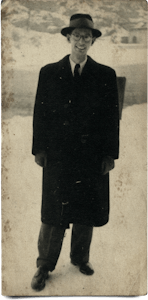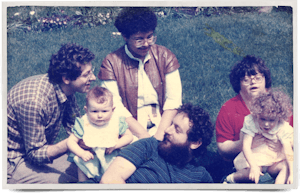John Chillag
After the Nazi invasion of Hungary in 1944, John and his family were imprisoned in a ghetto before being deported to Auschwitz-Birkenau. John survived various forced labour camps before being liberated at Buchenwald in 1945.



John was born in Vienna in April 1927 to a Hungarian father and a Czech mother. Due to the turbulent political climate in Austria, the family moved to the city of Györ in northwest Hungary in 1934.
John’s family owned a building materials business and his father worked for them as an accountant. With a large extended family and plenty of children his own age to play with, John had a happy childhood.
In March 1944, the Germans invaded Hungary. Life changed overnight for John and his family. They had to immediately start wearing a yellow star on their clothing and John was no longer allowed to attend school. Shortly after, all five thousand Jews living in Györ were forced into a ghetto. Without running water, decent sanitation, and only a little food, John and 35 members of his family lived in extremely overcrowded conditions:
“(Our extended family) were all in that one house, which wasn’t all that big to start with. And I suppose there must have been about 20 of us moving into what one calls today a two- or three-bedroom semi.”
Due to John’s fluency in German, the ghetto’s Jewish council used him as an interpreter and messenger to the SS. This was important to ensuring balanced relations between the Jewish community and German authorities.
The Nazi persecution of Jews in Györ’s ghetto escalated rapidly. On 11 June 1944, John and his family were forced onto cattle wagons. Although the train was intended to transport prisoners for slave labour in armament factories near Vienna, it was mistakenly routed in the wrong direction. After a long four to five-day journey, John arrived in Auschwitz-Birkenau.
John, his father, and uncle survived the initial selection and were admitted into the camp as slave labourers. John lied about his age and claimed that he was 20 rather than 17 years old to increase his chance of being accepted for labour. John and his father managed to remain together but they were separated from his uncle. They were shaved, given a prisoner uniform, and assigned a number which was to replace their names:
“I am 84007, my father was 84008, my uncle was 84006.”










John later discovered after the war that 58 members of his family were immediately gassed at Auschwitz-Birkenau, including his mother.
After almost two months in Auschwitz, John and his father were transferred to an armament factory in Bochum in Westphalia to work as forced labourers producing naval cannons. John worked on a steel forging press operating at 1000 degrees centigrade with no protective clothing. There was little food and their living quarters were cramped and dirty with poor sanitation. John’s father sadly died in Bochum due to the conditions that they endured.
In March 1945, as the Allied forces got nearer to Bochum, John was evacuated with other prisoners to Buchenwald concentration camp, near the town of Weimar in Germany. When John was liberated by American troops on 11April 1945, he weighed just 4 stone (25kg). He was so weak that he was unable to get down from his bunk and his survival was doubtful.
After a short convalescence at Buchenwald, the Americans took John into Czechoslovakia, and organised a special train to return all the Hungarian ex-prisoners to Hungary. Arriving in Györ, he discovered that no one from his family had survived. Half of his family home had also been destroyed by bombing, while Soviet soldiers were billeted in the remaining rooms.
Initially, John remained in Hungary to rebuild his family business, but it was nationalised by the ruling Communists in 1949. He was then conscripted into the Hungarian army, but he had no wish to serve in the armed forces, so he bribed officials with all of his remaining capital to postpone his service by a year. He took leave and fled the country.


As the escape westwards directly into Austria was too dangerous due to the barbed wire and minefields, John escaped by train to north-eastern Hungary. He climbed across the mountains to Bratislava (then in Czechoslovakia) and then crossed the Austrian border on foot. Eventually, John made it to safety in the American zone in Vienna, where he found refuge in a centre run by the American Joint Distribution Committee.
As a displaced person, John secured passage to Australia and arrived in Sydney on the USS General M B Stewart on 17 April 1950. Whilst working as an engineer with the Snowy Mountains Authority, John met his future wife, Audrey. In 1955, John became an Australian citizen. They had three children.
John and his family arrived in the UK in 1962 during an economic depression. He found a job as a specialist in German and Italian languages at the British Library in Boston Spa in Yorkshire. John worked there from 1963 to 1991.
Following retirement, John was headhunted by the Leeds Metropolitan University where he worked until 1997. He also volunteered to work on intellectual disability issues regionally and internationally.
John became a member of the Holocaust Survivors Friendship Association in 1996 and spent many years telling his story. He spoke to an estimated 20,000 schoolchildren and adult groups throughout the UK and Germany about his Holocaust experiences.
John passed away in March 2009, aged 81, and is sadly missed by all of his family and friends.







Can you help us?
Without the work of charities like ours, stories like John Chillag's will be lost and forgotten. Please donate generously to ensure that John's story can a force for good in the modern world.
- £
